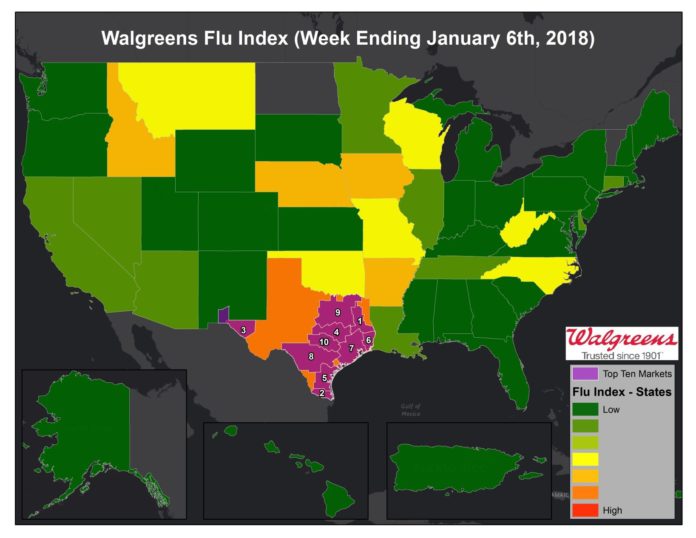Denton County Public Health and Tarrant County Public Health have reported a total of five flu related deaths.
DCPH reported its first and second influenza-associated deaths in Denton County for the 2017-2018 flu season Thursday, Jan. 11. According to a news release, there was one pediatric and one adult flu-related death.
TCPH received three influenza-associated death reports late Tuesday evening Jan. 9, marking the first voluntarily reported adult flu-related deaths of this flu season in Tarrant County, according to a news release. All three deaths involved senior adults (55+ years of age) with underlying medical conditions.
To protect patient confidentiality, no further identification information will be released.
“Our surveillance has indicated increased flu activity in recent weeks, and we anticipate high activity for the next several weeks,” Juan Rodriguez, DCPH assistant director and chief epidemiologist, said in the release. “It is important for residents to be proactive in practicing prevention through receiving the flu vaccine and taking action to prevent the spread of disease.”
DCPH and TCPH offer these tips for fighting the flu:
— Get a flu vaccine and avoid close contact with sick people.
— Wash your hands often and avoid touching your eyes, nose and mouth. Germs spread this way.
— If sick, limit personal contact to keep from infecting others. Stay home for at least 24 hours after your fever ends. It should be gone for 24 hours without the use of fever-reducing medicine.
— Cover your nose and mouth with a tissue when you cough or sneeze. Throw the tissue in the trash after you use it.
— If you get the flu, antiviral drugs can be used to treat your illness. They are different from antibiotics. They are prescription medicines and are not available over-the-counter. According to DCPH antiviral medications are a second-line defense against the flu.
DCPH also listed those at highest risk for flu complications, including:
— Pregnant women and women up to two weeks postpartum
— Children younger than 5
— Adults 65 years of age and older
— People living in long-term care facilities
— American Indians and Alaskan Natives
— People with chronic health conditions
According to DCPH, the best way to protect from the flu is to get an annual flu shot which can be administered to people ages 6 months and up. The organization recommends going to the doctor if symptoms such as fever, runny or stuffy nose, sore throat, cough, muscle aches and headaches present.
Influenza-associated deaths involving adults (18+ years of age) are not reportable to local health departments by Texas law, only pediatric flu deaths (0-17 years) are reportable. However, through TCPH’s constant communication with its healthcare community partners, the department anecdotally receives some adult death reports every year as well.
“It’s safe to say that we are currently experiencing a flu outbreak and these three voluntarily reported flu-related deaths reflect that,” said Chief Epidemiologist Russell Jones. This season is a mirrored reflection of 2013-2014, which was one of the more serious flu seasons of the past decade. Recognizing the early symptoms of this disease and consulting your healthcare provider, so you can get on an antiviral medicine like Tamiflu or Relenza, is advice that could lessen the severity of the disease for you.”
Residents can search www.vaccinefinder.org to find a location to get vaccinated in their neighborhood.
The number of confirmed flu cases at John Peter Smith Hospital in January rose to 278 today, up from 252 on Wednesday. This reflects positive lab test results from the hospital in Fort Worth (the Emergency Department, Urgent Care and inpatients). It doesn’t include JPS Health Network’s outpatient community and school-based clinics across Tarrant County.
Results since August:
August: 14
September: 39
October: 37
November: 73
December: 408
January to date: 278
For the latest information on flu in Texas, please visit www.texasflu.org, or visit www.cdc.gov/flu for details about symptoms, treatment and prevention.
________________________________________
The Walgreens Flu Index is a weekly report developed to provide state- and market-specific information regarding flu activity, and ranks those states and markets experiencing the highest incidences of influenza across the country.
Top 10 DMAs* with Flu Activity
Week Ending 1/6/18
1. Tyler-Longview(Lufkin & Nacogdoches), Texas
2. Harlingen-Weslaco-Brownsville-McAllen, Texas
3. El Paso, Texas (Las Cruces, N.M.)
4. Waco-Temple-Bryan, Texas
5. Corpus Christi, Texas
6. Beaumont-Port Arthur, Texas
7. Houston, Texas
8. San Antonio, Texas
9. Dallas-Ft. Worth, Texas
10. Austin, Texas
Top 10 States with Flu Activity
Week Ending 1/6/18
1. Texas
2. Iowa
3. Idaho
4. Arkansas
5. Nebraska
6. Montana
7. West Virginia
8. Wisconsin
9. North Carolina
10. Oklahoma
Top 10 DMAs with Flu Activity Gains
Week Ending 1/6/18
1. El Paso, Texas (Las Cruces, N.M.)
2. Wausau-Rhinelander, Wis.
3. Davenport, Iowa-Rock Island-Moline, Ill.
4. Cedar Rapids-Waterloo-Iowa City & Dubuque, Iowa
5. Palm Springs, Calif.
6. San Diego, Calif.
7. Milwaukee, Wis.
8. Duluth, Minn.-Superior, Wis.
9. Madison, Wis.
10. Los Angeles, Calif.
Top 10 States with Flu Activity Gains
Week Ending 1/6/18
1. Montana
2. Idaho
3. Iowa
4. Wisconsin
5. North Carolina
6. California
7. Oklahoma
8. Georgia
9. Delaware
10. Connecticut






